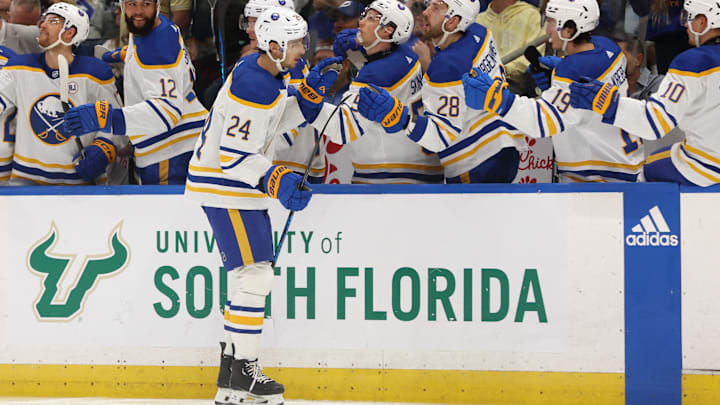If the Sabres want to contend in a rough Atlantic Division for the 2025 playoffs, there are more than a few statistics they must improve on. Last season, Buffalo couldn’t score, and some of the reasons for this are shown in the bleak stat lines below. But you’ll soon find out that their lack of scoring prowess wasn’t the only reason for their step back.
Overall, this team couldn’t gain or maintain possession, and while they landed a few more body checks than they did in 2022-23, Buffalo still lacked an edge. Let’s break down five pressing statistics from last season; statistics they can’t afford to remain lackluster throughout what will be a season of crossroads for general manager Kevyn Adams.
Power Play
We all saw this one coming, as the Sabres power play may have been a bigger disappointment than the team was offensively at even strength. They converted just 37 power play goals last season, despite the league average sitting at 52, a minus-15 differential.
This season, the team will adopt a more defense-first identity, so even if offense isn’t the focal point that it was intended to be last year, there is no way the power play can be this bad for the second year running. Either it gets better, or the Sabres can expect to keep stagnating, especially if they don’t improve on the following four statistics.
High-Danger Chances For at 5-on-5
Other than its goaltending and actual goals allowed, the Sabres had nothing going for them at 5-on-5, but their most atrocious statistic had to be high-danger chances for at 5-on-5. The league average sat at 627, while the Sabres finished with a measly 580, or just 7.0 per game.
Overall, that was a high-danger chances for percentage of just 45.7 when factored against high-danger chances against, which didn’t fare much better, by the way - 698 despite a league average of 627. The only reason I didn’t put the latter statistic into this piece comes courtesy of (primarily) Ukko-Pekka Luukkonen, who bailed out the Blue and Gold far too many times.
Hits per game
The Sabres weren’t a physical team under Don Granato, but that will change this season with Lindy Ruff back in town. Last year, the Blue and Gold landed 1,787 body checks, over 200 fewer than the bare minimum of what they needed if they’re serious about contending for the playoffs.
I say this because the best teams in the Eastern Conference last season, or the best teams not named the Carolina Hurricanes, were among the East’s most physical. Recent additions to the bottom-six should get the Sabres up to par, but actions will speak far louder than what we saw on paper from the likes of Beck Malenstyn, Sam Lafferty, Nicolas Aube-Kubel, Jason Zucker, and Ryan McLeod last season when they played in other uniforms.
Faceoffs won
Here’s a number to remember: 45.0. That was the Sabres faceoff win percentage last season, and it’s quite horrific. This is one of a few reasons why I was a fan of getting Ryan McLeod on board, but Tage Thompson, Dylan Cozens, and (maybe) Peyton Krebs need to hold up their respective ends of the deal.
Still, you would think any number is better than the one you see above, as losing so many faceoffs, especially in the defensive zone, makes winning that much harder of a job for the Blue and Gold.
Shooting percentage
While the Sabres 8.1 shooting percentage edged out the league average of 8.0 at 5-on-5, they struggled in all situations, converting just 9.6 percent of their shots on goal. The league average sat at 10.2 percent and, at worst, 10-flat is what the Sabres need to set as the standard.
Whether that happens is a mystery, as once again, and it’s been a theme throughout the offseason, that top-six scorer is still missing. That said, there are plenty of players they can move elsewhere to get that scorer, even if the odds of it happening so late in the offseason are less than slim.
(Statistics powered by Hockey-Reference)
